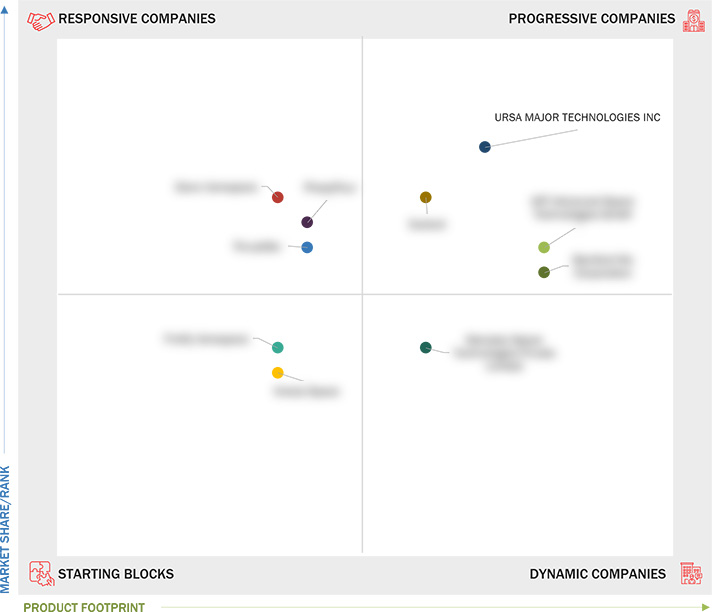Comparing 10 vendors in Space Propulsion Startups across 0 criteria.
✔️ What You Get with This Report
- 📊
Comprehensive Company Analysis - Business strategy, SWOT, financials, growth areas, M&A moves
- 🏆
Market Position & Share Insights - Visual competitive landscape (like the quadrant above)
- 🔍
Segment-level Benchmarking - Product, region, and end-user vertical
- 📁
Image & Report PDF Downloads - Ready-to-use for presentations and strategy sessions
- 📈
Demand Generation [Optional Buy] - License quadrant to drive demand & showcase leadership
✔️ Analyst-led
✔️ One-time payment
👉 Get Instant Access
The "Space Propulsion - Company Evaluation Report, 2024" comprehensively analyzes the evolving space propulsion market. This report, prepared by 360Quadrants, provides insights into market dynamics, competitive landscapes, and the key players shaping this industry. As we venture deeper into the space exploration and commercialization era, the propulsion market stands on the brink of revolutionary transitions. The report highlights critical drivers such as the growing deployment of satellites, advancements in propulsion technologies, and expansion into deep-space missions, which are crucial considerations for stakeholders and policymakers.
Furthermore, the study outlines significant opportunities presented by increased government investments in space programs and the emergence of novel propulsion technologies like nuclear thermal and nuclear electric propulsion. Stringent safety standards and high development costs pose notable restraints, but the market landscape is characterized by strategic innovations aimed at overcoming these challenges.
The stakeholders, encompassing government space agencies, private enterprises, satellite manufacturers, and research organizations, form the backbone of this diverse ecosystem. The report also explores how technological advancements are changing the dynamics, paving the way for emerging technologies such as electric propulsion systems, solar sails, and heat management systems. This document serves as a reflection of the current state and a roadmap directing the future trajectory of space propulsion technologies.
Key Developments
In March 2025, Ursa Major, a leader in advanced rocket propulsion systems, partnered with Palantir Technologies to implement Palantir's Warp Speed manufacturing operating system. This collaboration aims to enhance Ursa Major's manufacturing processes by integrating all manufacturing, business data, and logic into a unified command system.
In March 2025, Dawn Aerospace partnered with Reditus Space Inc. to provide propulsion systems for satellite-based on-orbit manufacturing. Reditus Space focuses on developing reusable satellites for zero-gravity manufacturing, targeting sectors like materials, pharmaceuticals, and biologics. Their upcoming mission, ENOS, scheduled for launch in March 2026 aboard a Falcon 9 rocket, aims to conduct pharmaceutical research and fully recover the satellite post-mission.
Startups in the Market
ThrustMe: This French startup, known for its involvement in the next wave of propulsion technologies, focuses on sustainable space travel solutions through innovative ion thrusters.
URSA Major Technologies Inc: Based in the US, this company has been significant in developing advanced propulsion systems, focusing on responsive and scalable solutions across sectors.
PhaseFour: A US-based innovator rich in venture funding, it has streamlined plasma thruster technologies for powerful propulsion solutions optimizing small satellite performance.
Exotrail: A French company, Exotrail is pioneering space logistics with flexible, electric propulsion solutions for a wide range of satellite missions.
Dawn Aerospace: From New Zealand, this startup is recognized for its pursuit of reusability and crossover technology between atmospheric and space flight.
1 INTRODUCTION
1.1 Study Objectives
1.2 Market Definition
1.3 Study Scope
1.3.1 Markets Covered and Regional Scope
1.3.2 Inclusions and Exclusions
1.3.3 Years Considered
1.4 Currency Considered
1.5 Stakeholders
1.6 Summary of Changes
2 MARKET OVERVIEW
2.1 Introduction
2.2 Market Dynamics
2.2.1 Drivers
2.2.1.1 Growing deployment of satellites
2.2.1.2 Advancements in propulsion technologies
2.2.1.3 Expansion of deep-space missions
2.2.1.4 Need for advanced propellants for long-duration missions
2.2.2 Restraints
2.2.2.1 High development and manufacturing costs
2.2.2.2 Stringent regulatory and safety standards
2.2.3 Opportunities
2.2.3.1 Increased government investments in space programs
2.2.3.2 Emergence of nuclear thermal and nuclear electric propulsion
2.2.3.3 Proliferation of LEO constellations
2.2.3.4 Surge in demand for reusable launch vehicles
2.2.4 Challenges
2.2.4.1 Supply chain disruptions
2.2.4.2 Rise of space debris
2.3 Trends and Disruptions Impacting Customer Business
2.4 Regulatory Landscape
2.5 Value Chain Analysis
2.6 Ecosystem Analysis
2.6.1 Prominent Companies
2.6.2 Private and Small Enterprises
2.6.3 End Users
2.7 Technology Analysis
2.7.1 Key Technologies
2.7.1.1 Electric propulsion systems
2.7.1.2 Solar sails
2.7.1.3 Ion propulsion
2.7.2 Complementary Technologies
2.7.2.1 Heat management systems
2.7.2.2 Advanced propellant management
2.7.3 Adjacent Technologies
2.7.3.1 Magnetoplasmadynamic thrusters
2.7.3.2 Autonomous propulsion
2.8 Patent Analysis
2.9 Trade Analysis
2.10 Supply Chain Snapshot
2.11 Market Forecast Assumptions
2.12 Key Conferences and Events, 2025
2.13 Investment and Funding Scenario
2.14 Macroeconomic Outlook
2.14.1 Introduction
2.14.2 North America
2.14.3 Europe
2.14.4 Asia Pacific
2.14.5 Middle East
2.14.6 Latin America
2.14.7 Africa
2.15 Business Models
2.16 Technology Roadmap
2.17 Propulsion Mapping of Satellite Constellations
2.18 Bill of Materials
2.19 Total Cost of Ownership
2.20 Impact of Generative AI
2.20.1 Introduction
2.20.2 Adoption of AI in Space by Top Countries
2.20.3 Impact of AI on Space Industry
2.20.4 Impact of AI on Space Propulsion Market
2.21 Operational Data
2.22 Volume Data
3 COMPETITIVE LANDSCAPE
3.1 Introduction
3.2 Key Player Strategies/Right to Win, 2020–2024
3.3 Revenue Analysis, 2020–2023
3.4 Market Share Analysis, 2023
3.5 Market Ranking Overview
3.6 Company Evaluation Matrix: Start-Ups/SMEs, 2024
3.6.1 Progressive Companies
3.6.2 Responsive Companies
3.6.3 Dynamic Companies
3.6.4 Starting Blocks
3.6.5 Competitive Benchmarking
3.6.5.1 List of Start-Ups/SMEs
3.6.5.2 Competitive Benchmarking of Start-Ups/SMEs
3.7 Brand/Product Comparison
3.8 Company Valuation and Financial Metrics
3.9 Competitive Scenario
3.9.1 Product Launches
3.9.2 Deals
3.9.3 Others
4 COMPANY PROFILES
4.1 THRUSTME
4.1.1 Business overview
4.1.2 Products/Solutions/Services offered
4.1.3 Recent developments
4.2 URSA MAJOR TECHNOLOGIES INC
4.2.1 Business overview
4.2.2 Products/Solutions/Services offered
4.2.3 Recent developments
4.3 PHASEFOUR
4.3.1 Business overview
4.3.2 Products/Solutions/Services offered
4.3.3 Recent developments
4.4 EXOTRAIL
4.4.1 Business overview
4.4.2 Products/Solutions/Services offered
4.4.3 Recent developments
4.5 DAWN AEROSPACE
4.5.1 Business overview
4.5.2 Products/Solutions/Services offered
4.5.3 Recent developments
4.6 AST ADVANCED SPACE TECHNOLOGIES GMBH
4.6.1 Business overview
4.6.2 Products/Solutions/Services offered
4.6.3 Recent developments
4.7 STANFORD MU CORPORATION
4.7.1 Business overview
4.7.2 Products/Solutions/Services offered
4.7.3 Recent developments
4.8 MANASTU SPACE TECHNOLOGIES PRIVATE LIMITED
4.8.1 Business overview
4.8.2 Products/Solutions/Services offered
4.8.3 Recent developments
4.9 KREIOS SPACE
4.9.1 Business overview
4.9.2 Products/Solutions/Services offered
4.9.3 Recent developments
4.10 FIREFLY AEROSPACE
4.10.1 Business overview
4.10.2 Products/Solutions/Services offered
4.10.3 Recent developments
Latest
Exotrail’s geostationary spacevan to launch on Ariane 6 in 2026
 Nov 2024
Nov 2024 spacenews
spacenewsExotrail deploys first satellite from orbital transfer vehicle
 Mar 2024
Mar 2024 spacenews
spacenewsFirefly Aerospace’s Firefly Alpha to launch Lockheed Martin’s FLTA006 Message in a Booster mission on Friday
 Apr 2025
Apr 2025 SatNews Publishers
SatNews PublishersUC Mechanical Engineering Student Helps Send Science to the Moon with Firefly Aerospace
 Mar 2025
Mar 2025 University of Cincinnati
University of CincinnatiCompany List



